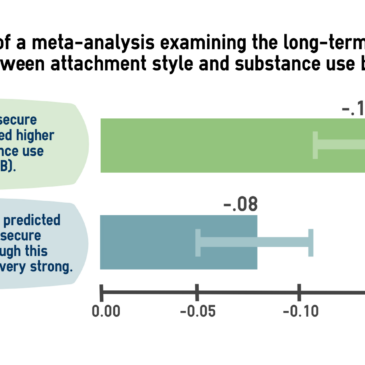The DRAM recently reviewed a study indicating that spousal substance use behaviors (SUB) might influence an individual’s alcohol and marijuana use behaviors and alcohol-related problems. Similarly, people who are involved in unhealthy relationships might be more likely to engage in SUB. One predictor of unhealthy relationships is attachment style, or how people relate to others during stressful situations. People who expect to receive support and care from partners are said to be securely attached. On the other hand, people who don’t see their partners as “safe havens” are said to be insecurely attached. This week, STASH reviews a study by Catharine Fairbairn and colleagues that explores how attachment style relates to the development of SUB.
What is the research question?
How does attachment style relate to the development of SUB?
What did the researchers do?
The researchers performed a meta-analysis of 34 studies that included a combined total of 56,721 participants and 182 effect sizes. They included only studies that (1) directly measured SUB or substance-related problems1; (2) assessed attachment style; and (3) assessed attachment style and SUB over time. The researchers used a random-effects meta-analysis to assess whether attachment style related to later SUB. The researchers used moderation analysis to explore if having an attachment figure (i.e., mother, father, family/parents, romantic figures, and close friends) influenced the strength of this relationship.
What did they find?
Attachment style and SUB significantly related to one another, regardless of the type of substance participants used. People lower in secure attachment at an initial assessment experienced increased SUB when measured later (see Figure 1). Likewise, higher SUB measured at an initial assessment predicted later lower secure attachment style, although this relationship was less strong. These relationships were apparent regardless of who served as an attachment figure in the participant’s life.

Figure. Results of a meta-analysis examining the long-term relationship between attachment style and substance use behavior. Note: Numbers represent significant correlation coefficients. Brackets represent 95% confidence intervals. Click image to enlarge.
Why do these findings matter?
How people relate to others is deeply connected with how they care for themselves, including their substance use behavior. Some people might experience a vicious cycle of using drugs, fracturing their relationships, and turning to drugs to cope. These individuals might benefit from programs that both reduce SUB and provide a supportive peer group.
Every study has limitations. What were the limitations in this study?
Meta-analysis is a useful approach to summarize what is currently understood about attachment style and SUB. However, the reliability of these results depend on the quality of the papers used in the analysis. This study couldn’t explain why these patterns emerged. One possibility is that people use substances to cope with loneliness and stress. Another is that people use substances to try to fit in and build new social bonds.
For more information:
If you think that you or anyone you know might be experiencing substance use or gambling-related problems, you can find help resources on the BASIS addiction resources page.
— Pat Williams
What do you think? Please use the comment link below to provide feedback on this article.
________________
[1] The authors refer to studies that measure either substance use behaviors in general or substance use disorder in specific as “substance use behaviors.”




